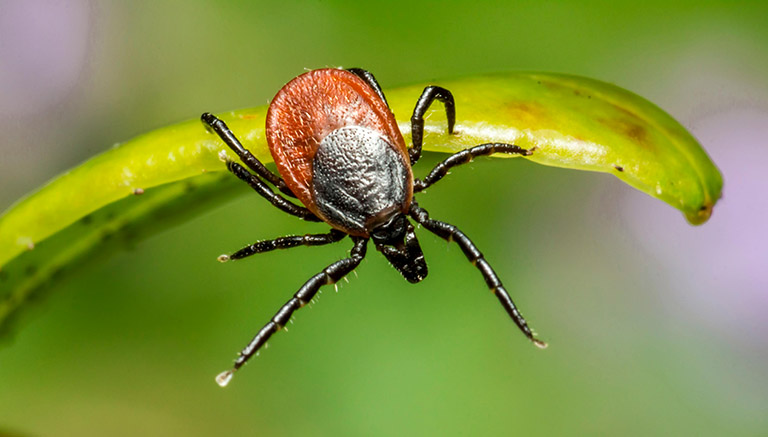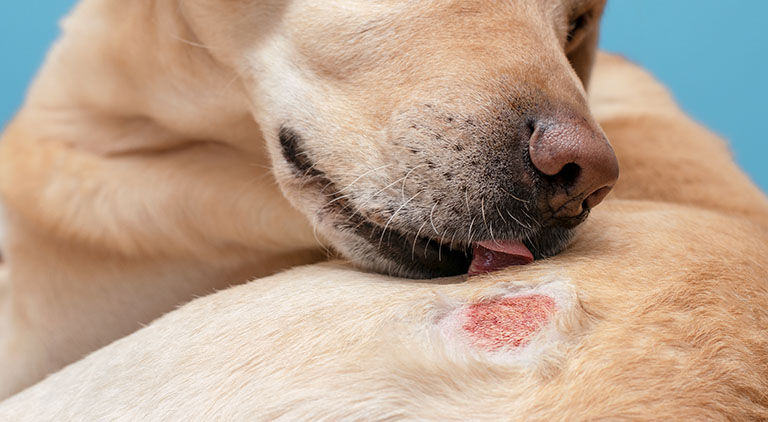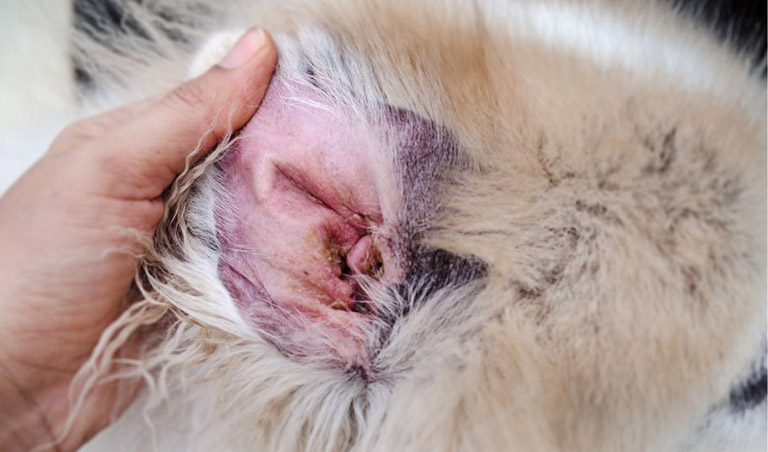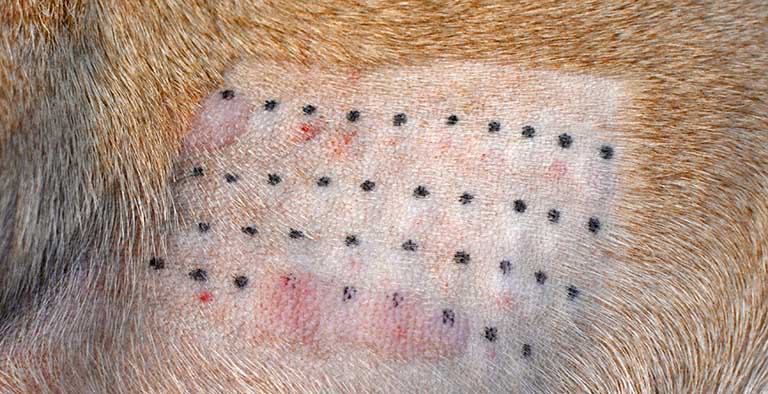Environmental allergies can wreak havoc on your beloved dog. From pollen and mold to dust mites and insects, these allergens can trigger a range of allergic reactions in dogs, leading to symptoms such as itching, inflammation and ear infections. In this blog we explore the common dog environmental allergies, discuss their signs and symptoms, diagnostic methods, management strategies, treatment options and natural remedies to help alleviate your dog’s allergies and improve their quality of life.
Environmental Allergies in Dogs
Environmental allergies in dogs manifest as an inflammatory response triggered by various allergens present both indoor and outdoor, such as pollen or dust mites. This reaction stems from an overactive immune system, leading to discomfort and distress for your furry friend.
Allergies are prevalent among dogs of all backgrounds and breeds, typically emerging after six months of age, with most cases affecting dogs between one to two years old.
Common Environmental Allergies in Canines
Pollen
Dogs can develop allergies to pollen due to their immune system’s response to foreign substances. Pollen consists of tiny grains released by plants as part of their reproductive process. When dogs inhale or come into contact with pollen particles, their immune system may mistakenly identify them as harmful invaders. In response, the immune system releases histamines and other chemicals, triggering an allergic reaction. Over time, repeated exposure to pollen can sensitize the immune system, leading to increasingly severe allergic responses in some dogs. Factors such as genetics, environmental influences and previous exposure levels can also contribute to the development of pollen allergies in dogs.

Mold and Mildew
Mold and mildew thrive in damp, dark environments, such as basements, bathrooms and areas with poor ventilation. When dogs inhale mold spores or come into contact with mold and mildew on surfaces, their immune system may perceive these substances as threats. Mold and mildew produce mycotoxins, which can further exacerbate allergic reactions and cause health problems in dogs.
Dust Mites
These tiny organisms are invisible to the naked eye and produce an allergen that can trigger allergic reactions in dogs. They flourish by feeding on shed skin cells and hair from both humans and animals, making it challenging to eradicate them entirely from the household environment. Commonly found in areas such as beds, mattresses, sofas, carpets and pet bedding, dust mites prefer warm and humid conditions for optimal growth. Exposure to dust mite waste can sensitize the skin’s immune system in some dogs, leading to the onset of clinical signs associated with atopic dermatitis.

Grasses and Weeds
Dogs frequently experience allergies to grasses and weeds, which can be triggered by inhaling pollen particles associated with these plants. Grass and weed pollen is airborne, meaning that your dog doesn’t necessarily need to come into direct contact with the grass or weeds to exhibit symptoms. Factors such as the specific species of grass or weed and the abundance of pollen in the surroundings can influence the likelihood of allergic reactions in dogs. These allergies can manifest as either skin reactions or upper respiratory issues.
Insects
Insects such as fleas, ticks and mosquitos can also contribute to allergies in dogs. When these little pests bite a dog to feed on their blood, they inject saliva into the skin to facilitate the feeding process. This saliva contains various proteins that can trigger an allergic reaction. What makes these allergies particularly challenging is that repeated exposure to the saliva proteins can sensitize the dog’s immune system over time. This means that subsequent bites from these insects may provoke increasingly severe allergic reactions. To learn more about how fleas, ticks and mosquitos affect your dog read here.

Signs and Symptoms of Environmental Allergies in Dogs
Itching and Scratching
Environmental allergies can present themselves in various ways. One of the most common signs in dogs is the incessant itching and scratching. If you notice your furry friend constantly pawing at their skin or rubbing against furniture, it could indicate an allergic reaction to environmental triggers.
Red, Inflamed Skin
Inflammation and redness of the skin can happen as a result of exposure to environmental allergies, particularly in areas where allergens come into contact with your dog’s body. Keep an eye out for patches of irritated skin, as well as hot spots, which can develop as a result of itching and scratching.

Excessive Licking and Chewing of Paws
Dogs with environmental allergies may exhibit a compulsive behavior of licking or chewing their paws as a way to alleviate discomfort. This action can lead to further irritation and even injury to the skin.
Hair Loss or Bald Patches
Allergic reactions can sometimes result in hair loss or the development of bald patches on your dog’s coat. If you notice unusual shedding or areas where fur seems sparse, it could mean that your dog is suffering from an allergic reaction.
Ear Infections
Environmental allergies can also affect your dog’s ears, leading to inflammation, redness and recurrent ear infections. Keep an eye out for signs of shaking of the head, scratching at the ears or a foul odor emanating from the ear canal.

Diagnosis of Environmental Allergies
If you suspect that your canine is suffering from environmental allergies, getting a proper diagnosis is the crucial first step in managing their condition effectively. Your veterinarian will conduct a thorough examination of your dog, paying close attention to their skin, coat and overall health. They’ll also ask you detailed questions about your dog’s symptoms, including when they first started and any potential triggers or changes in environment.
To pinpoint the specific allergens triggering your dog’s reactions, your veterinarian may recommend allergy testing. This can include skin tests, where tiny amounts of common allergens are applied to the skin to observe any allergic reactions, or blood tests to detect specific antibodies to allergens in the bloodstream.
Environmental allergies can sometimes mimic other skin conditions, so your veterinarian will also perform differential diagnosis to rule out other possible causes. This may involve testing for parasites, fungal infections or autoimmune diseases that could be contributing to your dog’s symptoms.

Management and Treatment Options
After receiving a diagnosis, you and your veterinarian can work together to develop a personalized treatment plan tailored to your dog’s specific needs.
Environmental Management Strategies
Minimizing exposure to allergens: Identify and minimize your dog’s exposure to common environmental allergens if possible. This may involve keeping your dog indoors during peak pollen seasons, using allergen-proof covers on bedding and furniture and regularly vacuuming and dusting your home to reduce allergen levels.
Regular grooming and bathing: Keeping your dog clean can help remove allergens from their coat and skin, reducing the likelihood of allergic reactions. Regular grooming sessions, including brushing and combing, can help remove loose fur and dander, while bathing your dog with a hypoallergenic shampoo can help wash away allergens and soothe irritated skin.
Use of air purifiers: Investing in a high-quality air purifier can help remove airborne allergens from your home, creating a cleaner and healthier environment for your dog. Look for air purifiers equipped with HEPA filters, which can capture allergens such as pollen to help reduce your dog’s exposure to these triggers.
Medications for Symptom Relief
Antihistamines: Medications can play an important role in providing relief and improving your dog’s quality of life. Antihistamines are commonly used to alleviate itching, sneezing and other allergic reactions in dogs. These medications work by blocking the effects of histamine, a chemical released by the immune system in response to allergens. While antihistamines can be effective for some dogs, it’s essential to work closely with your veterinarian to determine the right type and dosage for your pet.
Corticosteroids: Corticosteroids, such as prednisone or dexamethasone, are potent anti-inflammatory medications that can provide rapid relief from itching, inflammation and other allergic symptoms. These medications are typically used for short-term management of acute flare-ups but may have side effects with long-term use. Your veterinarian will carefully weigh the benefits and risks of corticosteroid therapy and may prescribe them in combination with other treatments for optimal results.

Allergy shots (Immunotherapy)
Another option for managing environmental allergies in dogs is allergy shots, also known as immunotherapy. This treatment involves administering small, gradually increasing doses of allergens to the dog over time, with the goal of desensitizing their immune system and reducing allergic reactions. While allergy shots can be effective for some dogs, they require a long-term commitment and regular visits to the veterinarian for injections.
Natural Approach
In addition to conventional medications and treatments, some pet owners may explore alternative or complementary therapies to help manage their dog’s environmental allergies.
Apple Cider Vinegar: Raw, organic apple cider vinegar is believed to work for dogs with environmental allergies due to its natural anti-inflammatory and antiseptic properties. When diluted and applied to the skin or used in a paw bath, apple cider vinegar may help soothe irritation and reduce inflammation caused by allergic reaction. Additionally, it can help remove allergens from the skin’s surface, providing relief from itching and discomfort. While the scientific research is limited, many pet owners and veterinarians find it to be a safe and effective home remedy for managing allergic symptoms in dogs.

Local Bee Pollen: Bee pollen, a blend of pollen collected by bees mixed with their own enzymes, offers potential in managing environmental allergies in dogs. This is because bees collect the very pollen that may be causing discomfort for your dog. By consuming small amounts of local bee pollen, your canine may experience desensitization to the allergens present in your area. It’s crucial to source bee pollen locally to ensure it contains the specific allergens relevant to your dog’s environment.

Nettle: Herbs such as nettle contain histamines that may provide a protective effect against allergens in the body. One way to utilize nettles is by drying them or brewing nettle leaf tea, which can be added to your dog’s food. Additionally, you can create a compress by applying the tea onto a clean cotton cloth and gently covering the affected area with it.

Omega-3 Fatty Acids: Research indicates that omega-3 fatty acids play a role in regulating the inflammatory response associated with allergies. These fatty acids can also assist in maintaining healthy histamine levels by utilizing their antioxidant properties. Mackerel and sardines are excellent dietary sources of EPA and DHA, two omega-3 fatty acids. Alternatively, you can opt for omega-3 supplements available in various forms to incorporate into your dog’s diet and support their allergy management.

Helping Your Dog Thrive
Managing environmental allergies in dogs requires a multi-faceted approach, including allergen avoidance, environmental management strategies and appropriate treatment options. By working closely with your veterinarian and implementing a personalized treatment plan, you can help reduce your dog’s symptoms and provide them with the relief they desperately need. Whether through medications, immunotherapy or a natural approach such as bee pollen and apple cider vinegar, there are various ways to support your dog’s allergy management and ensure their well-being. With patience, diligence and care, your dog can thrive despite their environmental allergies.



